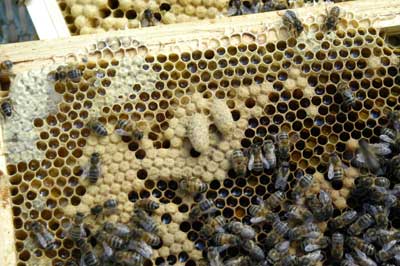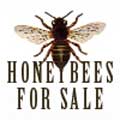Norfolk Honey - reasons for breeding your own queens

Breeding your own queens from the start
As you probably know beekeeping has been in the news a lot recently. As the
perception of how bees are suffering from disease, loss of habitat and the
damage due
to the use of pesticides bees will probably continue to be a hot topic for
the media especially as the causes of CCD are still not yet fully explained.
As a result of this exposure a lot more people
are taking up beekeeping.
Unfortunately it seems that there is now a mismatch
between the number of people who want to start bee keeping and the number of
people in a position to supply them with bees.
To make things worse the Varroa mite has slowly been decimating the number of
colonies in the wild. Wild (feral) colonies in the past would have been a regular
source of swarms that bee keepers collected and supplied to beginners to start
new hives with.
Rearing queens
Rearing queens in your first year of bee keeping possibly seems like trying
to run before you can walk. This isn't the case. Indeed the whole process of
breeding new queens is in fact fairly straightforward and easy to do if you have
the equipment ready to hand. In many ways breeding new queens is easier and less
trouble than extracting honey.
What I want to do is move the focus of new bee keepers in their first year
from making honey to increasing their stock of bees. I want new beekeepers to
fully understand how to feed their bees with sugar syrup to help them increase
their numbers and to be able to breed new queens.
I don't think new bee keepers are fully aware of just how many bees they need in their hive in order that they make honey and how necessary it is to build up their stocks by feeding their bees when a natural source of nectar isn't available and how simply it is to increase the number of hives they have with laying queens. Many of the beekeeping books talk at length about swarm control and associated queen rearing but often their
methods are just too complicated for the beginner.
My queen rearing course
Essentially my Queen Rearing for Beginners
course provides instruction to help you increase your laying
queens in a simple way. It's the knowledge I wish I had
been told before my first year of bee keeping. I'm going to let you in on
the secrets of easy queen rearing that will mean that your stocks
of bees from your second year of beekeeping onwards should never be so low
that
you loose them all in the winter and that the number of bees you have will
be high enough make you ample supplies of honey in the spring and summer.
However, you will need to be prepared to keep more than a single hive of bees.
Three or four hives, in my opinion, is the optimum number of hives for the
amateur bee keeper to take into the winter.
The winter is a time when, in recent years, bee keepers have been loosing bees.
Even established, experienced, old hands at the game have suffered higher winter
losses since the mite arrived. It is only prudent to be prepared for a percentage
of loss in the winter. Having a good number of well fed and treated colonies
set up by the time autumn arrives is the way to ensure that you enjoy your
beekeeping and the honey your bees will increasingly make.
Location, location
In you live in town with plenty of mature trees and gardens providing a good
variety of nectar sources for your bees then you are currently in one of the
best locations to keep bees. For one reason if no other, the chances of
your bees environment being pesticide free and virtually 100 percent organic
is increased in the city where large crop sprayers are never seen.
If you live in the countryside then you need to learn how best you can manage
both the feast and the famine your bees will experience.
Bees in both locations will make great honey for you if their stocks are good and healthy.
Happy beekeeping!

